HOW TO BUILD A CATIO WITH PVC PIPES
A PVC Catio is the best DIY catio build ever! It is easy, inexpensive, and fun to build. I will show you exactly how to build a catio with PVC pipes step-by-step and your cats will love you for it!
A couple of years ago I built a wooden cat enclosure, or catio, for my indoor cats. But, after a few years of storing it outside during the winter, it started to rot and get moldy.
When I first built it, I was afraid of sealing it in fear that the cats would chew on it and get sick. So, I took my chances and time took its toll. I thought about fixing it or building a new one, but it would just rot again. Therefore, I needed an alternative to wood and screen, so I thought “How about PVC?”
I found a lot of PVC cages you could purchase custom-made for a few thousand dollars each!!! YIKES! That wasn’t going to happen so, I decided to build my own.
BTW, I made the entire enclosure for $300.00.
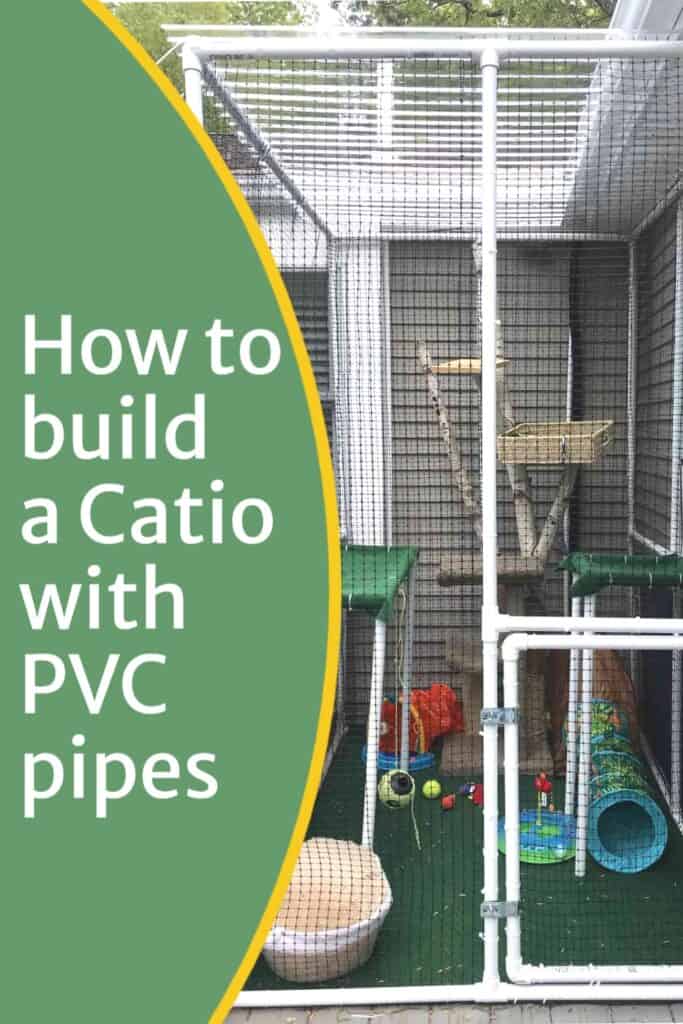
This post may contain affiliate links. If you choose to purchase a recommended product, I may receive a small commission at no additional cost to you. Rest assured that I will not recommend any product that I would not use myself. For our full policies and disclosures click here.
What is a Catio?
A catio is a structure built to allow your cats to have some outdoor time in a safe place. Also known as an outdoor cat enclosure, outdoor cat shelter, or cat run, a catio gives your kitty to get some fresh air and sun when they would otherwise be in danger of doing so.
Therefore, catios are purrfect for indoor cats. Do you see what I did there? LOL
Catios, or outdoor cat enclosures, can be made in many different configurations, materials, and sizes. If you’re building your own, you’re only limited to space available, your budget, and your imagination.
Why build a catio out of PVC?
There are a few different materials you could build your outdoor cat enclosure with, but in my opinion, PVC is the most versatile and easiest to work with. If you want to build an easy DIY cat enclosure, PVC is your best friend (next to your cat of course) 🙂
As I said above, building a cat enclosure out of PVC will allow you to keep it outdoors without fear of it rotting and falling apart. PVC is a plastic that cannot rot or break down so it’s perfect for outdoor use.
PVC is also very lightweight and will allow you to move the entire enclosure to another area if you wish. Or if you want to store it during the winter, you can easily take it apart to store it.
For those concerned with the effects of PVC, here are a couple of articles with both the pros and cons of using PVC products. Is PVC Safe? The Vinyl Debate, 7 Myths About PVC – Debunked
The PVC catio, or PVC cat enclosure, is made out of PVC pipes and plastic garden fencing.
A lot of you were concerned about other animals getting into the catio with the plastic so I wanted to give you another option. I just recently upgraded my catio using a wire fencing material that is more durable than plastic fencing. I must say that it is a lot sturdier but keep in mind that the cats can now reach thru this material because the holes are larger. Just something to think about.
I connected the sections using PVC connectors to make the frame and used zip ties to secure the netting to it. The roof is made out of clear plastic roofing material.
Update: I have since found a better way to attach the gate to the patio. Check out these PVC hinges updated in the supply list.
I also had a reader share her Catio with me and she found these products that are pretty interesting. You may want to check these out. Thanks Linda 🙂
12″ Hook and Loop Cable straps
12″ Poly Webbing Strap and Buckles
Pvc Cat Enclosure supply list and printable directions
I have made a list of all of the supplies I used to build my catio and included it in my printable version of this post with instructions. Your measurements could be slightly different depending on the size and configuration of your cage. But, if you decide to build yours to my exact specifications this would be your supply list.

How to build your catio frame out of PVC Pipes
I built the catio so that my cats can climb out of the living room window directly into the enclosure. But you can definitely build a totally enclosed, free-standing cage that you could put anywhere. One of the benefits of a PVC enclosure is that it’s very light so you can move it easily.
First, I decided on the overall size of the cage. This was easy because I already knew exactly where I wanted it to go (on my deck where the other cage was.) So I built it to those exact measurements. My catio’s finished measurements were 74″ long x 55″ wide by 90″ tall.
Design and sketch out your plan
The first thing you need to do is to determine what your catio will look like. I decided on making a basic 4-sided frame with a door on one end and a window on one side so they could have access from the house through a window.
Sketch out each of your 4 walls with measurements and any structures you want to add. This way you can see exactly what cuts you will need to make, how many, and what kind of connectors you will need. I added 2 perches for my cats so I needed to make sure to add 3-way connectors on my cross pieces. Read more about this below.
Start building your frame from the floor up
To begin building you will need to lay out your outer frame starting with the floor and working up. My overall measurements were 74″L X 55″W X 90″H. Make sure you have a little wiggle room because the final outside measurement will depend on your cuts and connectors.
Begin with your first wall. To measure out your cuts of the PVC pipe for each wall your basically going to take your full-length measurement and subtract 1″ for each place you will connect to a fitting.
For example, my first wall was the wall with a door. Because I needed to frame out my door opening I added a middle upright to the wall. See the image below. It measured 55″ wide total but had (2) 3-way fittings for the corners and (1) center tee fitting that connected two pieces of PVC on each side. So I needed to subtract 1″ X 4. (1″ for each end piece I’m connecting to and 2″ for the center fitting because it connects there in two spots.) This is an approximate formula that worked for me.
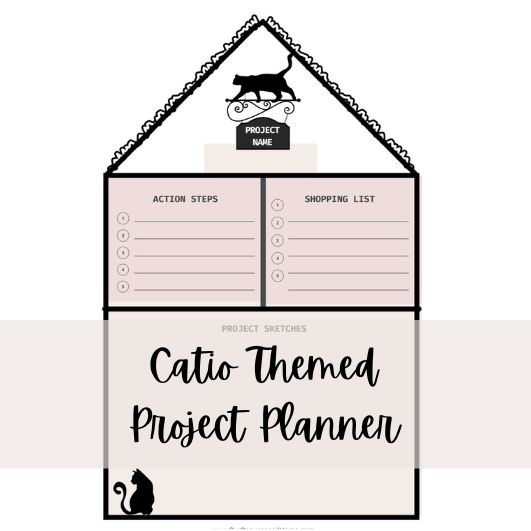
Start cutting your pieces and add connectors
Figure out your new length and cut a piece of PVC pipe to this length. Now you will cut this piece into two sections. If you have more than 2 sections you will cut your pipe into however many sections you have. 3 sections into 3 pieces, 4 into 4 pieces, etc.
You will need a ratcheting PVC cutter or a saw to cut your PVC. Here are some from Amazon or you can get them at Home Depot.
Now you need to add your connectors. You will need a 3-way connector for each of the ends to make a corner. Now you can connect your walls both vertically and horizontally.
You will also need a 3-way Tee connector to connect your wall sections in the middle for added support if your wall is long. Or add them if you are adding uprights for doors, windows, etc. I added middle connectors because I am adding horizontal cross pieces in the middle of two walls to connect perches for the cats. I want added support to hold it. Now you can connect your PVC pipes together to form your wall base frame.
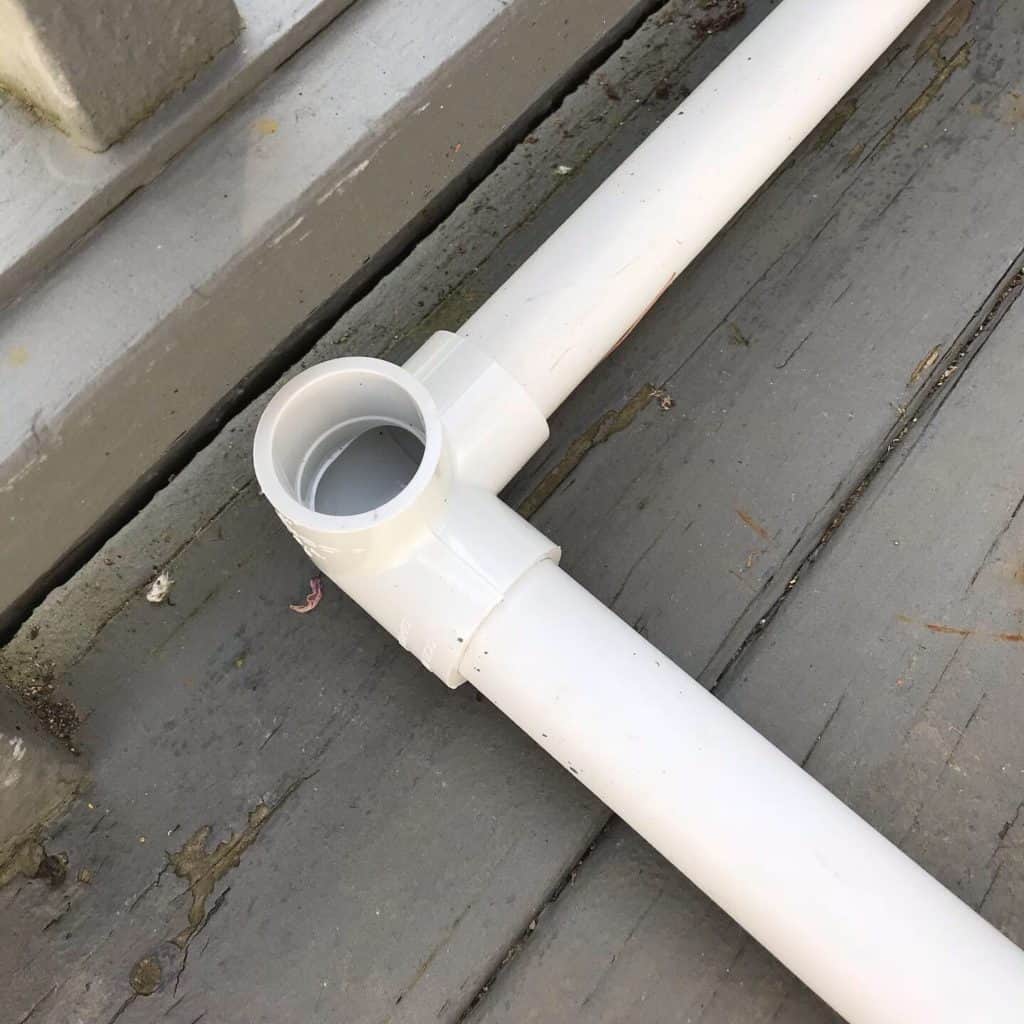


Begin adding the walls to the catio
Once you have your base frame connected you can start adding the uprights. First, you will need to determine the height of your frame and subtract any end connectors (top and bottom) and any middle cross pieces just like with the base.
For example: for my walls where I am adding the horizontal cross pieces I will need to subtract 1″ X 4 again. 1″ each for the top and bottom fittings and 2″ for the center cross fitting. If you are adding a door or windows you will need to keep the framing in mind so you will know how many cuts to make and the sizes.
Note: If you are going to add a solid roof then remember to make one wall slightly taller to allow rain to run off. Read more about this below.
Because of my perches and door, most of my uprights will be cut in half. See the image below. Both the right, left, and front sections need to be cut in two so you can add the horizontal cross pieces. The only upright that was the full length for me was the center in the back section. This is because I didn’t have any cross-pieces in the back. Center back upright not in the photo. Also, I changed out the wall connector on the front center section on the right to a 4-way elbow so I could frame the door. Read more about this under framing a door or window.
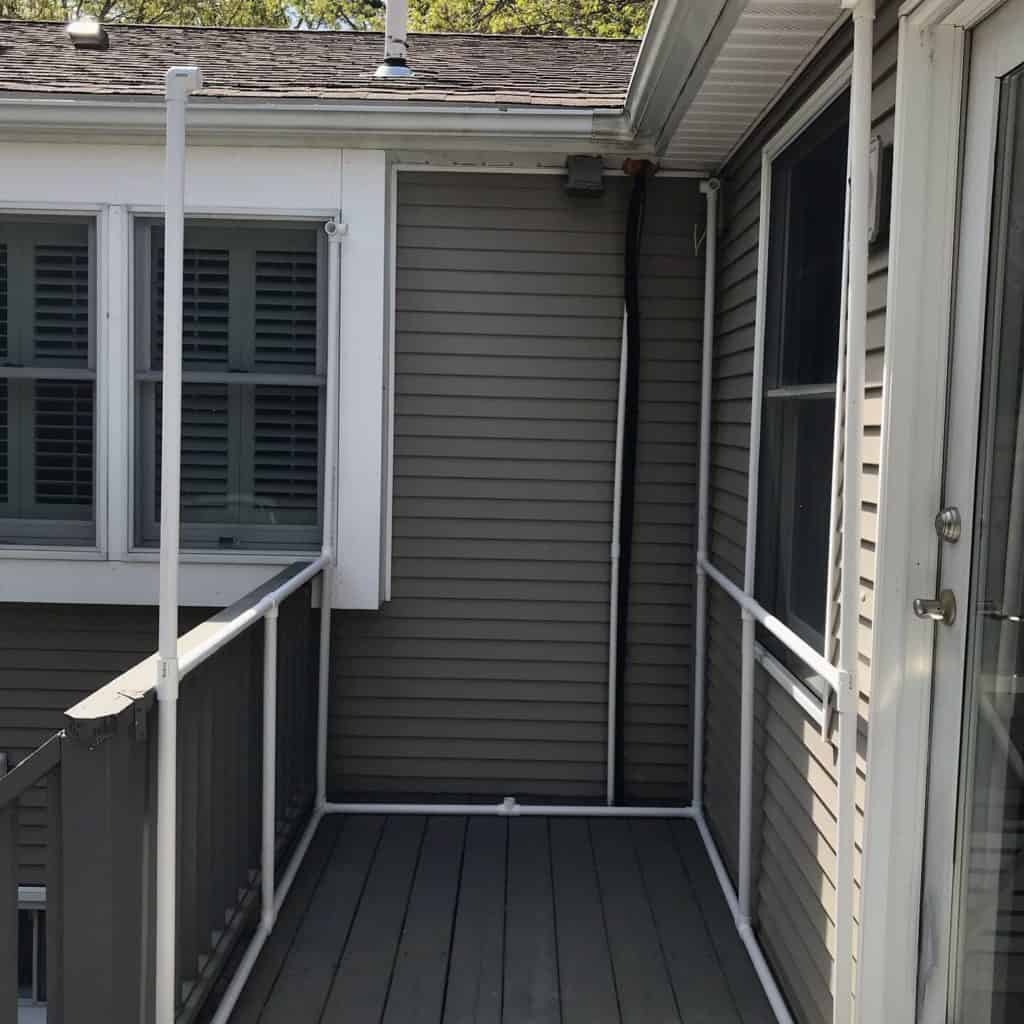
Framing a door or window in your catio
If you are building a door or window you will need to add more PVC pipes and connectors to the walls to frame them. See the image below for a visual example of a door

In order for me to build the front wall with the door I needed to change the upright walls a little. On the right side middle of the front wall, I needed to add a 4-way connector making this upright into two sections. This is so I could add a cross piece in two directions (one for the top of the door and one for the right side support in front of the window. I also added a Tee connector in the center upright making it into two pieces as well.
My door opening ended up being 35″ tall by 25″ wide so I made my door 34″ tall by 24″ wide. This left 1/2 inch all the way around the door.
You will then attach the door to the catio with PVC hinges and 2 – 3 1/2″ zinc swivel hasps.
Note: in the picture above it is just temporarily zip-tied so it looks like it has more space than that.

You might like this…
Do you want to give your cats Catnip but aren’t sure if it’s a good idea? I have a post about Catnip and its effects on your cats, how much to give them, and when it is too much. Read “Everything you want to know about Catnip“
Building a door
Building the actual door is the easiest part. You will just connect your PVC pieces using 90-degree elbows. Just measure the door opening, leaving 1/2 inch to an inch around each side. Then do the math of subtracting 1″ for each connection just like with the walls. My example: Opening = 34″ minus 2″ for elbows. And 24″ minus 2″ for elbows. This = 22″ PVC pipes for the top and bottom and 32″ PVC pipes for the sides.
How to make a window
If you were going to add a window then you would need two horizontal cross-sections and two vertical cross-sections. I actually didn’t frame the window I made next to the house. I just cut a section of the netting out and had the bottom cross-section which I used for a perch. This isn’t how I would have you do it. I really didn’t need support around the whole window for my design because it was up against the house.
Note: I couldn’t find an image of a finished window. You would basically build it the exact same way as a door, just in a smaller size and in the middle of the wall instead of at the bottom.
Attaching the netting to your catio
Once you have all four walls constructed and connected you can begin to attach the fencing. I purchased a roll of Blue Hawk Plastic Blanket garden fencing that was 4′ wide. This product was so easy to cut and install because it is made of plastic instead of metal. I hung the fencing from top to bottom connecting each piece with 8″ long zip ties. I did this all along each PVC pipe section from the inside.

Making sure your cats are secure
For the cats, I attached a zip tie every 6″ or so just so they couldn’t squeeze thru any opening. I used clear ties so you wouldn’t see them from the outside of the catio.
Note: Make sure when you are installing the fencing that you are cutting the zip ties short and turning them away from the inside of the catico. This is so your cats can’t get cut on them. Also, make sure when you cut your fencing to size that you trim off any pointy ends for the same reason. See image below
When moving on to the next section I overlapped the previous section a few inches. I did this just to add a little more stability and security to the fencing. Then I also attached the new section to the posts with the clear 8″ ties. And attached the fencing to itself with 4″ black ties to make double sure the cats wouldn’t sneak thru any openings

Move all the way around the entire enclosure adding fencing with 8″ ties to every PVC frame both horizontal and vertical, including window and door pieces. Once you finish adding all of the fencing you can cut any openings you need to for your door and windows. Again, make sure to trim off any pointy edges exposed.
Update: I have had some people mention that the garden fencing may not be secure at keeping other larger animals OUT of your catio. Although the fencing has been more than sturdy enough for keeping the cats in, I hadn’t thought about keeping other animals out because mine is on my deck, in my fenced-in yard, and we close it up at night so the cats are inside the house.
So, please be mindful when choosing what material you wish to use for the catio fencing. If your cats could be exposed to wild animals or dogs, you may wish to use chicken wire or some other metal fencing in place of plastic garden fencing. No matter what material you choose the assembly will be the same as long as the fencing is pliable and has holes for attaching it to the PVC.

You might like this…
If you don’t have outdoor space for your cats then how about giving them their own space inside? I’ll give you everything you need to think about including inspiration, projects, and products to give your cat the best Cat Room ever! Read: “Awesome Cat Room Ideas for your Home”
How to add a roof to your Catio
Now you could add fencing to the top if you wish, connecting it the same way as the walls. I decided to add a plastic roof to mine so the cats could still enjoy being outside even if it was raining.
I purchased 26″ x 6′ Corrugated Polycarbonate Plastic Roof Panels to make my roof. This is a thin, clear plastic, corrugated material. It was perfect to keep out the rain and to let the sunshine thru. My enclosure is in a corner next to my house so it doesn’t ever get direct sun, so I don’t have to worry about the cats getting too hot. However, they do sell colored and tinted panels if you want to provide shade for them.
To install them I measured my outer frame and added a little extra for overhang and cut them to that length. Then I connected 3 panels together, overlapping slightly to make my width. I connected them together by drilling 2 small holes close together where they overlapped, then secured them together with the 8″ zip ties. I did this about 4 times across each overlapped section.
Finally, I attached the whole thing to the top of the catico frame by drilling holes near the edges and also using zip ties to secure it.
Make sure you leave a slight pitch if you’re going to use a roof so any rain will drain off. These panels are not very rugged and if rain collects on them they will sag. I am also planning on adding a cross piece of wood or plastic decking board to the top of the catio just to help support the middle of the roof in case of heavy rain. You could also switch out your top/middle connectors with a 4-way connector and add a pipe across the middle of the roof for added support.
Or you can add the pitch simply by having one wall slightly higher than the others. You don’t necessarily need to cut one wall higher though. Just hammer down all the other sides so the PVC pipes are sitting into the fittings a little bit tighter. This should be all you need for the water to run off.

Building the perches inside your Catio
Now it’s time for the fun part…adding some structures for your cat to relax and play on.
I decided that I wanted two perches for them to lounge on. I added one in front of the window (also as a landing for when they come into the enclosure.) The other one was on the opposite wall so they could look down over the deck.
To make these I had already installed 3-way connectors where my cross pieces were. Now I just had to add some small pieces of PVC pipe and two more 3-ways to connect them. This allowed me to give the perches legs for stability. I made my perches 14″ x 14″ near the window and 36″ x 12″ along the deck.
Next, I used some Green Indoor/Outdoor Area Rug pieces and attached them to the perch frames using zip ties. This gave them a soft place to relax. You can use any type of sturdy fabric you want to make them as long as it can be out in the weather.

Add finishing touches to your Catio
Finally, I finished the whole project by adding the GreenRug to the floor of the catico. It’s not quite grass but gives it the look of grass. Or you can use any type of outdoor rug to give your catio some personality.
Then it was time to decorate and bring in the toys. I had already made a cat tree out of a purchased stand, some pieces of a birch tree, and a basket. So, I put it in the catio and it fit perfectly. Now they have something to climb on.
Then I added a ball that I hung from one of the perches and a few store-bought playthings for them to explore. I really think they love it!

PVC Catio plans, printable PDF version



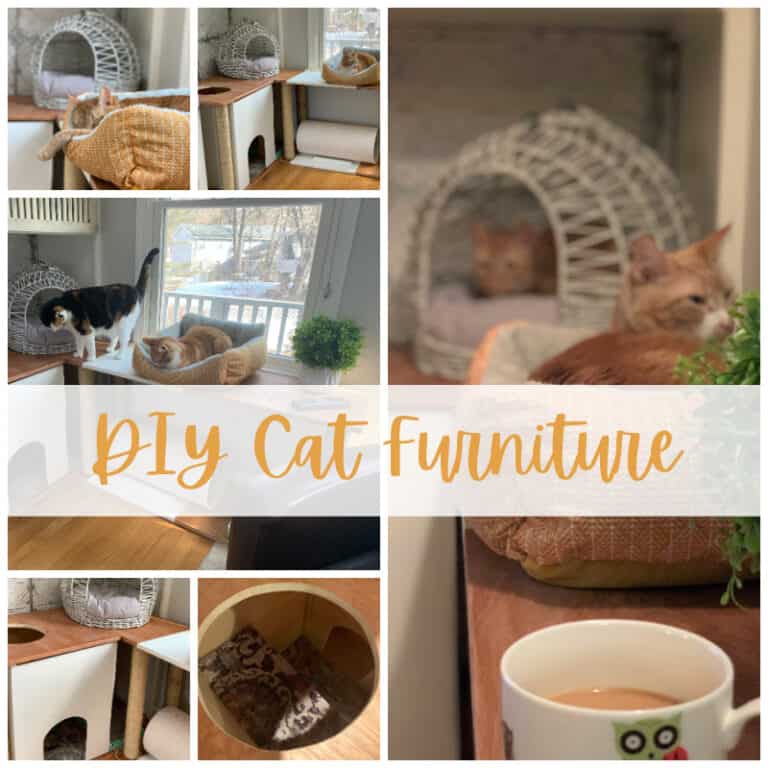





Great plans – thank you so much! I have perches at two levels and wanted sturdy platforms so kitties can jump from one to the other and found these plastic sheets worked well:
https://www.lowes.com/pd/PLASKOLITE-T-x-W-x-L-White-Corrugated-PlasticSheet/3381288
Covered them with outdoor carpet attached with zip ties. Thanks again for sharing your plans.
Thanks John, That’s a great idea! So instead of having kind of a soft bed perch, you have more of a shelf. Brilliant Thanks for sharing.
Me again, wanted to share something funny about my kittens & our catio I made using your awesome plans & instructions. My enclosure is 72″ high, I used the same netting on top, as I did on the sides. It is inside my master bathroom. It was for a stray mother cat, before her kittens were born. We never ebded up catching her. Kittens I have & fostering love to climb on the cat scratcher & climb up on the roof, some older kittens look like Spiderman crawling up the entire side. They love sleeping on the roof, up high. I put some towels on top for them to lay on. It’s like their big hammock!! I look in the vanity mirrors to see which ones are up there. It being in the bathroom, dark (1 window) it is like their sleeping quarters.
❤️
I Love your Catio. Thank you for sharing with us. I have a couple of questions. Why did you make your door so small? Is there anything other than zip ties to secure netting? Clamps would work for the top. Not sure about the rest? I made a catio enclosure to put in my master bathroom temporarily. Works great except I am constantly cutting my arms & legs on the zip tie ends (that had been cut & facing outward). Other than sanding all of those sharp edges, anything else I can do or use? I made a door the height of my enclosure 72″ (72″ so I can move it through the doorways), should I use 2 clamps or 3 on the door? I want to build a larger one in my yard. Thank you!!
Hi, I made the door small because I didn’t really think I needed it to be any bigger. Although I wished I had made it bigger when trying to decorate and I had to crawl in and out of it. as far as the zip ties scratching you, You can turn them so that their sideways and then it won’t hurt you or the cats. I have seen some PVC clamps that could hold the netting, but you would need a lot of of them and I’m not sure how sturdy they are and if you have a tall door, I would definitely use three clamps to make sure it’s sturdy in the middle.
Wow! Beautiful design! Can’t wait to get to work on one. Thank you for a very well-written article. 👍
Thank you Peter and good luck!
Thanks for helping me with the basic design. It’s really helped me tremendously with the needed dimensions, T’s & especially the connections for the gate In my doorway.
Your very welcome!
Hi!! I noticed that you put the plastic fence inside of the pvc poles and not outside the pvc poles. That make the fence look formless, if it were outside the pvc poles would look more defined and much stronger and safer.
Hi Mary, Yes I put it inside the pvc. In my mind I didn’t want to see all the black netting around the white pvc poles so that’s why I did it. But, you are 100% correct. It makes more sense to put it on the outside for structure purposes. I recently redid it with a different fencing and put it on the outside. It does make it neater but it is bothering me seeing all the black pattern around the white poles. Sorry, little things like that drive me crazy! 😉
Your ideas are fantastic! Just my opinion, though, on where to put the netting … I think it’s best to run your netting or fencing on the inside of the posts with the posts on the outside and here’s why….. if the posts are on the inside with the netting on the outside the animals could very easily push their way out of the enclosure. The netting would stretch out far without the support of the posts to hold it back potentially loosening fasteners and connectors that were holding the netting in place. Really, it could compromise the integrity of the entire structure depending on how much pressure they are putting on it. With the netting on the inside they can’t push it out very far, the posts stop it. Also, they could get stuck between the netting and posts, especially if the catio butts up against a fence or wall. I sort of speak from experience!!
Thanks Lisa, I always appreciate comments from experience. I did originally have my netting on the inside but it didn’t look neat…I kind of cut corners a little bit…literally. But, having the netting on the outside really does help with holding the whole thing together neatly. But either way will work for sure.
Thank you so much. This is the best set of comprehensive instructions I found online. I am going to try this.
What size pvc pipe did you use? Im having a hard time finding a latch for the door that will attach. I used 1” pipe.
Hi Shelly, I used 1″ pipes. Here are the links for the gate hardware. Snap on hinges… https://www.amazon.com/dp/B06XJF3MJ5/ref=as_li_ss_tl?_encoding=UTF8&psc=1&linkCode=ll1&tag=ourrepurpos08-20&linkId=db42eddab6f9d176c9e3fd0708cb1635&language=en_US Swivel Hasps … https://amzn.to/3svUf1k
Thanks, that gate latch was what I was looking for. I wish there was a way to send pics, this enclosure is huge! 😻
email me the pics! I’d love to see them! info@ourrepurposedhome.com
We just built our own 8 ft tall, 3.5 ft wide catio based on your design. The supply list, and your detailed description was so helpful! It took us about 5-6 hrs to complete. It’s tall enough to accommodate our 2 huge cats, a large cat tree and our patio window, which swings open into the enclosure. The cats love it, and it is quite sturdy. We built it next to a railing, and used straps with release buckles to anchor it in place. We also used the same Blue Hawk plastic garden fencing on your supply list. It’s quite strong! I don’t think our cat can chew through this easily. Thank you so much for sharing your catio plans!
Oh, I’m so glad my post helped you! Send me some pictures. I’d love to see it.
Amazing Lori, It’s Cheap and Beautiful. Excellent explanation of the build for the catio. I will make it for my Cat
Thank you Diana, Good luck with your Catio 🙂
I would think that the garden fencing may also not keep out squirrels.
I have a ton of squirrels and chimpmonks in my yard but never had an issue with them trying to get into the catio. It may just be that there isn’t anything for them to want to get in for. ex. food
This idea looks purrfect for my situation! I am renting and getting a new kitten to add to the family but we have eagles and coyotes around but I want to get my new baby some safe outdoor time. This seems like a great solution for my project I am going to do today and hopefully make my fiancé super excited!!!! Thank you for posting this!
Sam, if you have coyotes then please make sure you use something stronger than the garden fencing. All the instructions will still be the same.
Hardware cloth is great fencing where there are wild animals.
Thank you Mary!
Hi,
Quick question – When connecting the PVC pipes to the fittings, did you use PVC pipe cement?
Hi Scott, I did not use cement. However, mine is kind of wedged between my house and deck railing and the netting pretty much holds it together anyway. But, if you are concerned with it coming apart, by all means use cement. But, keep in mind that you will not be able to dissasemble it if you need to.
Have you noticed your cats chewing on the plastic garden fencing?
Hi Terri, The only time my cats chewed on the fencing is when we put our new kitten out there for the first time. I was sitting on the deck and he was trying to get to me. He did this one day and never tried again. And there was no damage. The other two grown cats – never.
Thank you so much! I am going to try and create one myself in the next few weeks using this fencing.
Yay! Good luck.
putting cats in this very toxin emitting environment is a dumb idea.Especially when the sun hits it, it’s even multiples worse. you were better off using a non toxic water based strain on the wood enclosure. And your plastic fence will crack and deteriorate in no time. hope your cats don’t get sick or escape when the plastic fence seams separate.
Pattianne, Thank you for your comment about the PVC catio. I completely respect your stance on the use of PVC. However, there are many, many products that we use on a daily basis containing pvc including roofing, siding, water pipes, windows, vinyl fencing, flooring, cookware, car parts, toys, clothing, handbags, pools, plastic furniture, and many more.
However, I appreciate your concern and I will add information to my article with a link to the pros and cons of using pvc.
Thank you, Lori
While PVC does contain harmful carcinogens, VCM is merely a part of the production of vinyl. Once PVC is produced, VCM is no longer emitted, so it doesn’t pose a threat to anybody who uses vinyl. Dioxin can only be released from PVC when it is burned at low or extremely high temperatures.
Clyde, Thank you for your reply. There is a back and forth about the effects of PVC and I want my readers to know both sides so they can make an informed decision. I did add some links to the post with both the pros and cons of pvc. Thanks for writing, I appreciate it.
absolutely wrong. PVC is completely safe once it’s cured. It’s actually where most of our drinking water travels in new construction. However for the sake of argument any wood you put outside like this would have to be pressure treated. I wouldn’t even plant vegetables near pressure treated wood. The cats are also more likely to chew on or scratch up wood as opposed to PVC putting that a far greater risk of contact with chemicals.
I live in Florida and it’s quite hot and sunny. A good portion of patio furniture here in Florida is made from PVC. Stands up just fine to the elements. Calling someone dumb and then pushing your own idea which is far riskier is somewhat ironic.
How easy is it for cats to knock over? Cats can be really rambunctious.
Good question. Mine is wedged between my house and deck railing so there’s no way that can happen. But you can use u brackets to attach to the deck floor or house to secure it. If you have it in a grassy area you could use stakes. It’s quite large so even without anything I doubt they could do it. But better to be safe then sorry.
I need something like this to stop my cat from jumping off my second floor balcony railing!! She is fine during daylight hours but at night when there are all those wonderful noises it gets too much for her.
You don’t actually say what size PVC pipe you used.
That’s a great idea for your escape artist. Lol. I used 1” PVC pipes
Here’s the link for the supply list. https://www.ourrepurposedhome.com/catio-supply-list/
How did you attach the catio to the house?
I would try using “U” brackets to attach it. This way it can wrap around the PVC pipe and attach to the house with screws. Or if you don’t want to drill into your house with screws you can attach it to the deck floor the same way. I don’t have mine attached because it is wedged between my house and the deck railing.
If you don’t want to do either then you can make a tunnel that goes from the window thru the opening in the enclosure. You would use your window to hold the tunnel on the house end and attach the other end directly to the pvc enclosure. This way the cats wont be able to have access to the enclosure any other way. I have mine like this. I purchased at cat door for a window and the tunnel goes right to the flap so they cant get around it. If your not attaching the enclosure to anything then I would make sure the house end of the tunnel is attached to the window opening.
I hope this helps. If you have any other questions please feel free to ask.
This is absolutely amazing. Thank you for sharing!
Thank you Anna, glad you like it.
I am thrilled to find your directions. It’s solidifying what I thought and adding some extra things. One of which is why plastic fencing? You said your new kitty is chewing on it, I don’t see how plastic could stand up to a cat. I was thinking of using the lightest chicken wire – thoughts? I will be using a clearish plastic roofing used on barns so I know it can hold snow load, if we have any, and add more supports in general. I don’t have room to store it indoors. Any thoughts on winterizing it – giving it extra strength?
Hi Ann, I used the plastic fencing because that was what I read was a good option. After a few readers suggested that it might not be strong enough I decided to update the post to reflect that. I did say that my kitten was chewing on it but he wasn’t successful at damaging it at all. That’s why I feel safe with the plastic fencing. I however do not have to worry about any danger of other animals getting in because it’s in my fenced in yard on my second story deck. Any bendable fencing with holes would work with the exact same directions so go with whatever you feel comfortable with.
We don’t use the Catio in the winter. All we do is takeoff the roof because it will not hold snow, and leave the rest of the structure right where it is. Because it’s PVC it’s perfectly fine to leave it outdoors. Are you planning on having the cats use it during the winter?
I built a partition in my Class C motorhome so it blocks off the cab. That way when we are travelling we can get in and out of the cab without fear that one of the cats could escape. I put a gate in the partition so we could then get into the back safely when the cab doors are shut. We don’t use the side door when the cats are on board. I used a galvanized screen a bit stronger than chicken wire to be extra safe. It works very well.
That’s a great idea. I’m trying to figure out how to take them with us safely. When it’s just my husband and I I’m not too worried but when we have the grandkids that’s another story. I hope I can figure something out.
Hi Did you use ordinary hinges for the door? What did you use to hold the door closed? I can’t wait to get started on this 😻😸😺
Hi Liz, I used aluminum hinges and swivel hasps but another reader suggested these aluminum snap on hinges for pvc. I hope this helps.
hinges for pvc pipe
What part of the US are you in, do you have exrtreme heat or cold where you are? We do where I live and I wonder how durable the PVC is. We build a woodframe without treating and it only lasted 10 years. and I am looking for an alternative material.
Thanks
Leslie
Hi Leslie, I live in the northeast in MA. We get all kinds of weather. I’ve had the pvc catio for two winters and it hold up very well. I do however remove the roof because it would never hold the snow we get. Your lucky that your untreated wood catio lasted ten years! Mine lasted only two! 😊
This is totaly cool! I needtomake one for my cat! Thank you so much for sharing.
Thanks Susie
Hi,
Is there a way to get your instructions and supply list? I really need to do this for my cats.
Hi patty, yes. Click on the link in the post for the list and sign up and the password will be emailed to you. If you have any issues please email me at info@ourrepurposedhome.com
Thanks Lori
Hi Lori,
I had to send you an email at info@ourrepurposedhome.com.
Can’t wait to try this.
Just replied to your email. I hope that helps
Hi, I love this DIY. Was the garden fencing strong enough to last against any attempted climbing or chewing from the cats? Let me know! I am trying to decide between metal and plastic.
Hi Lindsey, until yesterday I haven’t had an issue with the cats chewing or climbing the fencing. But we have a new kitten who we just introduced to the catio. I was sitting on my deck and he was not happy that he couldn’t get to me and started climbing up the side and frantically chewing at the bottom to get to me. He did not succeed and eventually gave up. I did not see any damage though. I made the mistake of taking him out thru the door of the catio and I think that’s why he was trying to chew there. He saw that that section opened up. 🙄. I will let you know if this becomes an issue but honestly I think he will get used to it and not try again.
How would you attach it to the house so it doesn’t pull away and allow escape route?
Hi Amy, I would try using “U” brackets to attach it. This way it can wrap around the PVC pipe and attach to the house with screws. Or if you don’t want to drill into your house with screws you can attach it to the deck floor the same way. I don’t have mine attached because it is wedged between my house and the deck railing.
If you don’t want to do either then you can make a tunnel that goes from the window thru the opening in the enclosure. You would use your window to hold the tunnel on the house end and attach the other end directly to the pvc enclosure. This way the cats wont be able to have access to the enclosure any other way. I have mine like this. I purchased at cat door for a window and the tunnel goes right to the flap so they cant get around it. If your not attaching the enclosure to anything then I would make sure the house end of the tunnel is attached to the window opening.
I hope this helps. If you have any other questions please feel free to ask.
Lori
Thanks Lori! I’m going to build one!, but put it inside for the winter, then attach it to the house outside or build another one when spring comes. I’ve never had cats and have 2 terrier dogs I don’t trust with the cats. I want the cats to be able to come upstairs and be able to still go downstairs for their litter. I live in a rural area and there are huge coyotes here.so it will be a death sentence if they go outside. A month ago I heard a pack of coyotes howling in woods nearby, then a cat screech, then complete silence in the woods near my house. These little kitties are now healthy, spayed and vaccinated They were skinny & flea infested when they showed up (dropped off most likely) in August One was super friendly & the other was not. I just fed them a month while they lived outside until I could capture them both a mont later. So my plan is to build a PVC enclosure 12 ft long, 2 feet wide, 6 ft tall so it will fit under the door in the spring when I can put it outside the egress window. I will put it along the railing to the basement in the upstairs open concept LR/Dr/kitchen. They will still have access to the huge unfinished but heated & AC basement where I already created a cat paradise out of moving boxes. Am in Europe x 3 weeks and come home Saturday. Have live in sitter caring for the 2 dogs/ 2 cats while gone. Will work on this project as soon as I’m home! Thanks again you have some brilliant ideas Nancy
Nancy, that’s a great idea! I bet the dogs and cats will become friends by the end of the winter. This is a great way to introduce them and get them used to being around each other. I can’t wait to see it when it’s done!
I love this idea as I have made something unrelated out of PVC pipe. I would like this up against the house where there is an egress window to the basement where my new stray kitties are. Please explain how to attach it to the house or to the window as I am unclear on how you did that. Also, would cats use this in the winter in a cold, snowy climate? If I put the same material you used for the top on the sides, just for the winter, do you think they would use it? I will use a heavy duty cat door in the window. Thanks
Hi Nancy, What a great idea to use this for your basement window for your strays! I love it!
I do not have my enclosure attached to the house or the window. It sits right up against the house and doesn’t have room for the cats to squeeze between the house and the enclosure. It is sitting in between the house and the deck railing which holds it pretty tight to the house. However, before I made this enclosure I had another one that I made out of wood and screens and this one I made a “tunnel” of sorts between the window and the enclosure. That way the only access they had was through this tunnel. You could definitely make a tunnel that attaches to the pet door and goes directly into the enclosure.
But if you need to attach it somehow you could use u clamps and attach it to the house or a deck floor. Here is a link for you.
Nge 3inch Rigid Pipe Strap Clamp. Just make sure you get the ones for the size of the pipes your using.
Also, here is a link for the pet door that I purchased. I love it. Its very heavy duty and fits perfectly in the window. Ideal Pet Products Aluminum Sash Window Pet Door, Adjustable to Fit Window Widths from 27″ to 32″
As far as them using it during the winter, I usually take mine down. However, now that I have this heavy duty pet door I’ve noticed that it isn’t cold near it…yet. I’m thinking of leaving it up until we get snow because the roof will not hold any weight. Or, maybe I could add something on top of the roof for more support for the winter. I’ll have to think about that some. If I were you I would try it for the winter and see if the cats are interested in going out. I guess they would let you know if it’s too cold and stay inside. Just remember you’ll need to support the roof with something other than what I used. They do make heavier roofing panels that could work. I just liked the see thru one that lets in light.
Let me know what you decide and how it works for you.
Lori
Perhaps you could add a regular house awning (normally used above windows) they make all different types (or diy your own) that would give an extra layer & sturdier roof protection & not directly on top of your catio roof. Maybe a Pergola type idea, with weatherproof material attached underside or on top. I live in Phoenix, Arizona so we’re always trying to block sun & heat.
Love those ideas. Thanks for sharing
Came across this as I was looking for a way to build a non-permanent catio for our cats. We live on the second floor and have a large patio. Our cats are very curious so I was hopping to make a space outside that was safe for them because I see our patio turning into a great summer hangout compete with a cat-friendly patio garden.
This would be perfect for you. You can make it any size you want and it’s very lightweight. Let me know how it turns out.
Thank you for such an excellent explanation of the build for the catio. The information is exactly what I need. Looking forward to making a happy place for our 4 cats.
I’m so glad to hear that Merrin. Let me know how it goes. I’d love to see pics of your happy cats.
Thank you for such a well written and explanatory build of a catio with PVC pipe. I recently moved from acreage to an in town residence. I am using the chain link panels from my dog kennel. I am always looking for ways to incorporate ideas like shelving, catio covering, and decor items I think my cats would like. My kennel is in the back of my yard, but your PVC design also gave me an idea on how to make a cat walkway our of the board, wire and PVC. Again, thank you. I enjoy the read.
Thank you Annette i’m glad you found the blog post helpful. I’d love to see pictures of your catio and your walkway when you finish it 😊
I want to be able to build one for my cats but up stairs in my loft area what would be a good idea for that ., because due to others in the home they can’t roam around .
Annette, you could use the same plans I have but eliminate the window. Just measure the space and adjust the height if necessary.